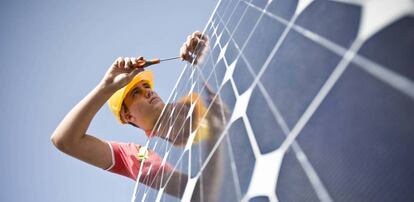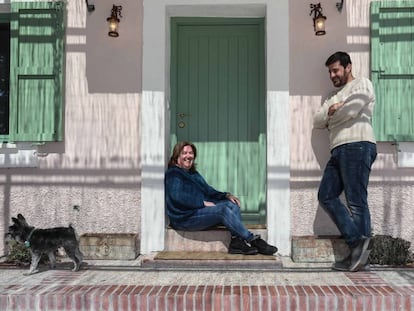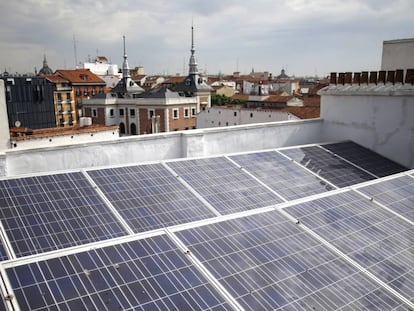Solar panel systems soar in Spain thanks to friendlier regulation
Companies say they are being overwhelmed with demand after a government decree eliminated bureaucratic hurdles and installation prices dropped dramatically


The sun has been shining on SpainˇŻs self-produced energy sector ever since new regulations were approved in April by the Socialist (PSOE) government. Since then, demand for photovoltaic solar panels by homes and businesses has soared.
Although it is still early, The Spanish Photovoltaic Union (UNEF) is already talking about ˇ°an enormous renewed interestˇ± in solar energy self-generation.
We used to get a couple of requests a month, and now weˇŻre dealing with around 20 a day
Pilar P¨¦rez, Leroy Merlin
Last year, 235 megawatts (MW) of new photovoltaic power were added in Spain, and this year the industry expects to see an installed capacity of 400 MW, says Jos¨¦ Donoso, director general of the industry association.
Most of this extra power is being demanded by small and medium businesses and by the industrial sector, which stand to benefit the most because they can produce and consume energy simultaneously.
For now households, which typically have 3kW solar power systems, represent around 10% of self-generation from the sun, but Donoso is expecting that figure to rise throughout the year.

Now that self-generation is legal and makes economic sense, companies are working round the clock to meet the demand. Gone are the administrative hurdles kept in place for years by the right-wing Popular Party (PP) administrations. And the price of installing solar systems has dropped by nearly 80% in just one decade. Even some local authorities are incentivizing self-production with lower property taxes for homes with solar systems.
A spokesperson for the renewable energy company Holaluz said that they are being contacted by 300 clients a week requesting a quote, and setting up five systems a day. The company expects to have installed 1,500 systems by the end of the year, and 5,000 by 2021. These are mostly home systems for stand-alone houses and other installations that do not send excess production back into the grid. In 2017, the company set up the first shared self-production system, which is also legal since April, in a residential building in Rub¨Ş (Barcelona).
Even traditional utilities like Iberdrola and Endesa are vying for a piece of the pie in this ebullient new market. Requests for photovoltaic installations have soared 140% at a company named SotySolar.
Households, which typically have 3kW solar power systems, represent around 10% of self-generation from the sun
ˇ°WeˇŻve gone from being two workers a year and a half ago to a team of 11, and weˇŻre still short on people. WeˇŻre having real trouble keeping up with demand,ˇ± says Jos¨¦ Antonio Gonz¨˘lez, the sales director for Red-Fotovoltaica, the company that does turnkey installations for clients of the do-it-yourself giant Leroy Merlin. A spokeswoman for Leroy Merlin confirms this peak in demand.
ˇ°We used to get a couple of requests a month, and now weˇŻre dealing with around 20 a day,ˇ± says Pilar P¨¦rez, head of the companyˇŻs Renewable Energy Products. There are even real estate developers such as Neinor Homes that offer buyers of apartments in El Ca?averal (Madrid) a photovoltaic panel and battery system for €19,900.
Energy storage
Experts are convinced that in very little time, apartments will not just have energy-producing panels, but also storage batteries. The greatest energy savings come from storing energy that is not immediately consumed. UNEF estimates that around 25% of self-production installations in Spain right now have a storage system.
ˇ°Compared with last year, demand for equipment has doubled, and ever though the rate of batteries for homes that are not stand-alone houses is still low, we expect to see significant growth from now on,ˇ± says Ignacio Osorio, the CEO of Ampere Energy, a Spanish company that produces and sells electric batteries.
Helping this growth along is the fact that the price of batteries has also been dropping, at a rate of around 80% since 2010. The price depends on capacity. ˇ°For a 2.5kW residential system, the battery would cost between €3,000 and €4,000,ˇ± according to UNEF. But there are batteries going for €12,000 as well. Panels generate the most energy during the day, when most users are not at home. The battery stores that energy so it can be used at night, or on a cloudy day, and avoid having to resort to the grid. It can also purchase electricity from the grid when it is cheaper.
According to Alexandre Diez Baumann, vice president of the Association of Batteries and Energy Storage (Aepibal), investing in a battery can mean rates of return of over eight percent. But other experts feel that the investment is simply not worth it
ˇ°The grid can serve the same purpose as a battery at a lower cost, with zero investment and no technological risk whatsoever,ˇ± says Gonz¨˘lez, of Red-Fotovoltaica. ˇ°Because of the structure of energy billing in Spain and current regulations, the economic arguments in favor of batteries are generally insufficient compared with self-generation without storage.ˇ±
English version by Susana Urra.
Tu suscripci¨®n se est¨˘ usando en otro dispositivo
?Quieres a?adir otro usuario a tu suscripci¨®n?
Si contin¨˛as leyendo en este dispositivo, no se podr¨˘ leer en el otro.
FlechaTu suscripci¨®n se est¨˘ usando en otro dispositivo y solo puedes acceder a EL PA?S desde un dispositivo a la vez.
Si quieres compartir tu cuenta, cambia tu suscripci¨®n a la modalidad Premium, as¨Ş podr¨˘s a?adir otro usuario. Cada uno acceder¨˘ con su propia cuenta de email, lo que os permitir¨˘ personalizar vuestra experiencia en EL PA?S.
?Tienes una suscripci¨®n de empresa? Accede aqu¨Ş para contratar m¨˘s cuentas.
En el caso de no saber qui¨¦n est¨˘ usando tu cuenta, te recomendamos cambiar tu contrase?a aqu¨Ş.
Si decides continuar compartiendo tu cuenta, este mensaje se mostrar¨˘ en tu dispositivo y en el de la otra persona que est¨˘ usando tu cuenta de forma indefinida, afectando a tu experiencia de lectura. Puedes consultar aqu¨Ş los t¨¦rminos y condiciones de la suscripci¨®n digital.










































